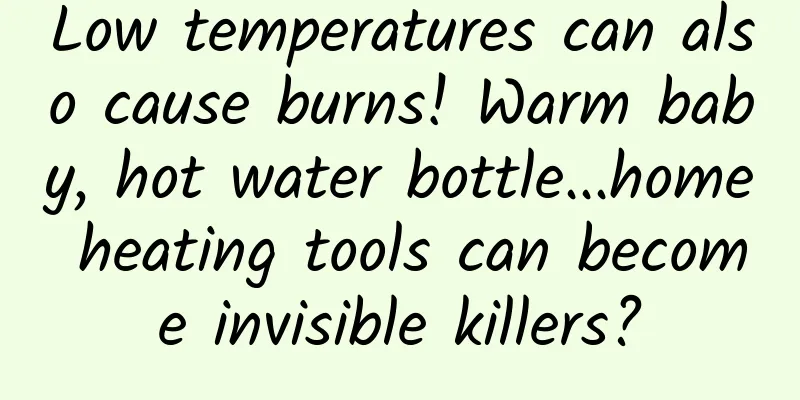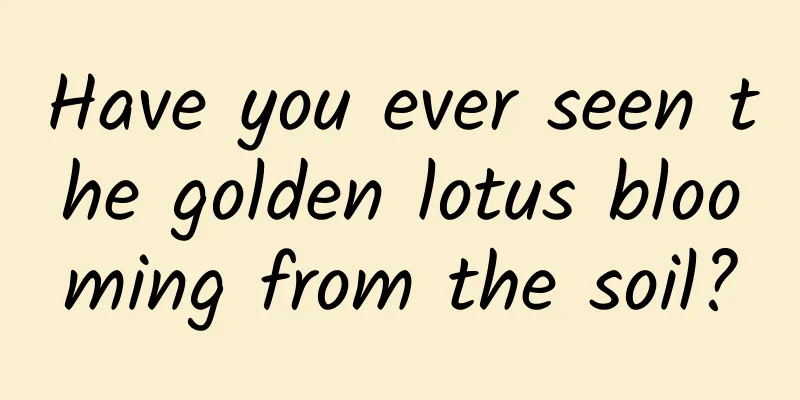Low temperatures can also cause burns! Warm baby, hot water bottle...home heating tools can become invisible killers?

|
As winter arrives, it’s time for the north to rely on heating and the south to rely on righteousness to keep warm. The shivering southerners have to resort to various heating tools: hot water bottles, heat pads, fire boxes... At this time of year, the emergency department always encounters many patients with burns. In addition to the usual burns caused by boiling water or hot oil, there are also some unconventional burns, such as burns caused by hot packs, moxibustion, etc. Image source: soogif What? These "guys" look so gentle, but are they really that powerful? In fact, this type of burn is called "low temperature" burn. Today, let’s talk about what low-temperature burns are and what are the hazards? Who and in what situations are low-temperature burns more likely to occur? How to determine if low-temperature burns have occurred? And what should we do after they occur? 1. What are low-temperature burns and what are their hazards? When the temperature is too high and the skin or other tissues are damaged, we call it a burn. In addition to the well-known boiling water, other causes can also cause burns, such as chemicals, flames, electric shocks, radiation, friction, etc. The degree of burns is closely related to the temperature of the heat source and the duration of contact. Burns caused by high temperature are the most well-known type of burns. Its prevention and treatment are certainly important. However, the other type of burns is not easy to detect due to its low injury temperature. It is like boiling a frog in warm water, harming people invisibly. Its existence should not be underestimated. We call the chronic damage to the skin or other tissues caused by long-term contact with this lower temperature (44℃-51℃) "low-temperature burns." Image source: CCTV Finance What kind of harm will such special burns bring? As a type of burn, it will bring the common harms of burns, such as skin redness, swelling, pain, damage, infection, necrosis, ulcers, scars, etc. If the burn is in a special location, it will also cause joint movement disorders, sensory disorders, abnormal appearance, and even have an adverse effect on mental health. On the other hand, since low-temperature burns generally have a long contact time, the heat energy is further transferred to the deep tissues through continuous accumulation to cause damage. Compared with high-temperature burns, this chronic process allows more heat energy to accumulate and the thermal damage is more severe. Moreover, this unique method makes the damage of low-temperature burns not obvious in the early stages, and it is easy to be misdiagnosed as mild burns, resulting in untimely and inadequate treatment. The risk of delayed wound healing, chronic pain, and even functional abnormalities will also be higher. Diane Baxter was burned by low temperature of mobile phone | Source: Internet 2. People and situations prone to low-temperature burns So who is prone to low-temperature burns? There are mainly three types of people and three types of scenarios. People who suffer from low-temperature burns often have one or more risk factors of functional impairment, which can be mainly divided into three categories, including cognitive and expressive dysfunction, action dysfunction and abnormal perception. Cognitive impairment: including children and people with low intelligence. Infants and young children have immature perception and judgment abilities and are unable to recognize potential dangers. More importantly, they do not have the ability to move or evade, and are easily burned by humans. It is also difficult for them to accurately express themselves through language, resulting in prolonged burns and the condition being ignored. Image source: pexels Perceptual dysfunction: including the elderly and patients with partial damage to the nervous system such as diabetes and hemiplegia. Although the elderly have richer awareness of burn risks and life experience than people with cognitive impairment, their skin becomes weaker with age, their skin perception weakens, and their ability to respond to temperature changes is slow, making it difficult for them to detect the risk of low-temperature burns. In addition, the elderly have an increasing demand for moxibustion and health care equipment, which happens to be prone to low-temperature burns, which increases their risk of low-temperature burns. Patients with damaged nervous systems such as diabetic peripheral neuropathy and hemiplegia have a reduced perception of burns due to their physical illness, making them more susceptible to prolonged low-temperature burns. Image source: pexels Abnormal movement function: People with limited mobility in life are also susceptible to low temperature damage, such as the disabled, alcoholics, etc. For patients with burns caused by alcoholism, drugs, etc., in addition to the movement disorders caused by alcoholism and drug use, the slow nerve reflex caused by alcohol and drugs is also one of the causes of chronic low temperature burns. There are also three main scenarios in which "low-temperature burns" occur. The first is heating, including hot water bottles, hot compresses, electric blankets, etc. The second is medical operation, including moxibustion, cupping and infrared lamp. Some scholars have conducted research on patients with low-temperature burns in Beijing and found that improper use of moxibustion is one of the main causes of low-temperature burns, and most cases occur at home. In this regard, another scholar pointed out: It is recommended that the distance between the burning moxa stick and the skin is about 3-4 cm, and the time is 30-60 minutes. If the distance is too short or the time is too long, there is a high probability of low-temperature burns. In addition, there are also many reports of low-temperature burns caused by long-term close use of heating appliances such as mobile phones. 3. How to determine if you have been burned by low temperature? The severity of burns is usually assessed based on the burn area and burn depth, but low-temperature burns are mostly small in area but generally more severe in severity. So how do we judge? Low-temperature burns are not easy to detect, and require a certain amount of time to accumulate. When they are discovered, deep tissue damage has already occurred. Therefore, unlike high-temperature burns, which cause intense pain and large blisters, low-temperature burns are more likely to cause persistent mild pain or touch pain or burning sensation in that area after long-term contact with a lower temperature heat source. Generally, there are no blisters or very small blisters, and the blisters are relatively dark in color. Over time, the wound surface gradually becomes infected, tissue necrosis and chronic hyperplasia occur. 4. How to avoid low-temperature burns and what to do after burns? If low-temperature burns occur, please follow the principles of "don't do it, and do it as soon as possible." First , do not use folk remedies, such as applying soy sauce, vegetable oil, or sprinkling lime on the wound. Not only will it not effectively treat burns, it will also easily increase the risk of wound infection and even affect the doctor's accurate judgment of the burn condition during treatment. 2. Go to the hospital as soon as possible . Generally, the burn plastic surgery department is more professional in this regard. The early treatment is mainly to clean the wound surface and change the dressing to prevent infection and promote repair. Since low-temperature burns take a long time to recover and the healing effect is poor, some large areas, long-term burns or burns in key parts may involve surgical treatment later. Image source: pexels In the kitchen, there is an open flame, boiling water and heating oil, and high temperature burns are terrible! In the room, children are unattended and the elderly are unaccompanied, so be careful of low-temperature burns! Since risks exist, we should maintain risk awareness, and if problems exist, we should recognize them early. With this scientific knowledge, we should pay attention to the elderly and children around us. I believe that we can greatly reduce the occurrence of accidental injuries and respond correctly. Source: Chongqing Science and Technology Museum Author: Wei Yi, one of the top ten science popularization ambassadors in China Statement: Except for original content and special notes, some pictures are from the Internet. They are not for commercial purposes and are only used as popular science materials. The copyright belongs to the original authors. If there is any infringement, please contact us to delete them. |
>>: What is the limit of rocket reuse? The vertical recovery "posture" must be correct!
Recommend
Android fragmentation report released
According to foreign media reports, Android fragm...
Getting Started Guide to Short Video Promotion!
From the traditional "two Weibo" to tod...
A 6.1-magnitude earthquake struck Lushan, Ya'an, Sichuan! Save! An effective guide to escaping and self-rescue in the event of an earthquake
The China Earthquake Networks Center officially d...
Revealing the 315 hacker wifi, how to ensure APP data security?
The 315 Party exposed WIFI security, demonstrated...
How to develop an addictive app?
Although there are a total of 5 million apps avai...
New version of Microsoft Launcher released: improved UI and battery life
Microsoft Launcher 6.2.201202.9334 for Android wa...
Clinical Application of Movement Assessment System Course Series
Introduction to the clinical application series o...
Is the information flow promotion effect not good? Maybe you overlooked this!
Written in front This article is based on the gam...
At the just-concluded Chinajoy, what muscles did BAT flex?
[[144293]] The four-day Chinajoy has officially c...
Is it expensive to develop a Chuxiong Lighting mini program? Chuxiong Lighting Mini Program Development Cost List
The launch of mini programs has brought convenien...
Practical traffic diversion: How to build a traffic diversion and promotion system?
A word of advice: I would like to build an ecolog...
Tim Cook and Jack Ma are among the candidates for Time's Person of the Year 2014
On December 9, according to foreign media reports...
Apple vulnerability does not affect Alibaba APP
SourceDNA, an American application analysis servi...
I received a box of hairy crabs, but I can’t finish them. What should I do?
"When the autumn wind blows, the crabs' ...
iOS and Android mobile versions are coming soon, and Microsoft has opened a new Bing based on ChatGPT to applicants.
Microsoft is inviting more users to test the new ...









